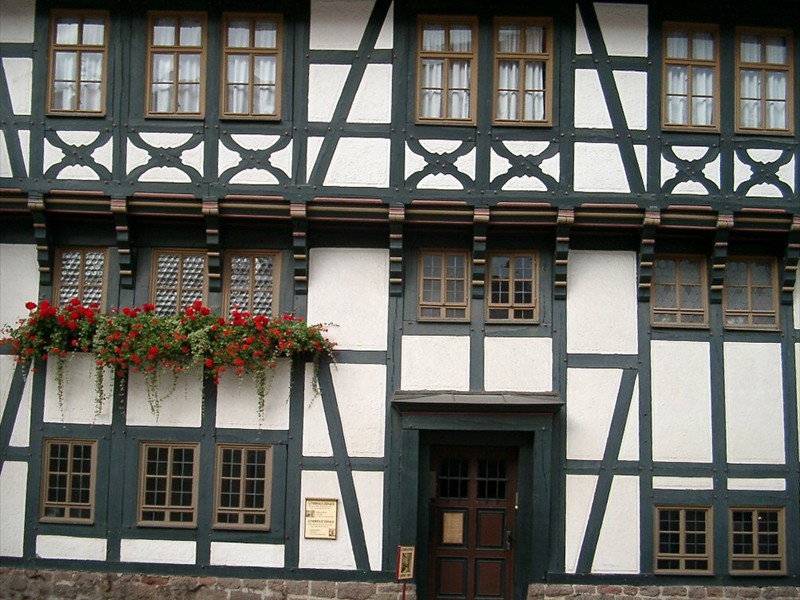The Augustiner Kloster in Erfurt offers an excellent breakfast buffet, like in a four-star hotel. Well fortified, we set off in the direction of Gotha. It's a steep climb and the sun shows its effect. We stop behind a dung cart and change. Still going uphill, the side road ends, we have to take the busy road. But then we discover the cycle path on the other side of the road. Once there, I realise that my gloves are no longer there. Desperately I search all my pockets. I decide to ride back to the place where we changed clothes, but then I find them. They were wrapped in the jacket.
On the way to Gotha we get a bit lost and have to re-plan the route. Instead we come to beautiful quiet asphalted side roads lined with plum trees. Wonderful!
Back on the Way of St. James, we follow the signs into the centre of Gotha. A fantastic town. We park our bikes in front of the church. It is already noon and we plan the rest of the day. Hans has an idea: he wants to ride to Eisenach today and then climb the Wartburg without luggage. Then we could skip the Wartburg and the ride through the hilly Thuringian Forest the next day and ride along the Werra to Vacha.
Gotha, on the northern edge of the Thuringian Forest, was first mentioned as "Villa Gotaha" in 775 in a document of the Frankish king Charlemagne, making it one of the oldest settlements in Thuringia. The residential town of Gotha has had town charter since the 12th century.
The geographical publishing house founded by Justus Perthes in 1785 published the Gothaer Adelskalender, which became world-famous as the "GOTHA", until 1943.
The picture shows the Margarethenkirche on Neumarkt in Gotha. The Gothic "bridal portal" with the statues of Luther and Melanchthon is remarkable. You can zoom in on it with the plus button! and enlarge the pictures of the statues by clicking on them!


I like Gotha as a small town very much. There are still many Renaissance and Baroque houses. I'm particularly interested in the Friedenstein Palace of the Princes of Saxe-Coburg-Gotha. It's much bigger than I imagined; it's huge. A baroque jewel.
I push the bike up the hill and ride into the gigantic castle courtyard and buy a ticket for the tour. To see everything, all the exhibitions, the palace park and orangery, you have to allow at least half a day. I have just under an hour. But that's enough for the most beautiful rooms and the baroque theatre.
Time is pressing. Hans is already sitting in the café waiting for me. After all, I want to eat something! it will be a slice of pizza.
The ride to Eisenach becomes an adventure. After Kleinrettbach we lose the sandy cycle path and end up in a meadow. We think somehow it goes already further. that ends in the total fiasco and we have to go back again. Over an adventurous bridge we reach together with the brook over a valley. The brook really flows over the bridge!
On the other side we find the bike path again.

Cycle path around the Hörselberge (Hörsel mountains). The pilgrims path leads over the mountains.
Finally, a nice bike path again, or a side road and we come to Sattelstädt. The pilgrimage route leads over the Hörselberge and we cycle around it on cycle paths and the B7. The shell signs lead us to Eisenach. Already from Gotha I made a reservation for us by phone in the deaconess home. The voice on the phone was very pleasant and the concerned question whether we wanted coffee for breakfast was very reassuring. The reception is exceedingly warm. The sister with whom I had spoken shows us the pilgrims' room. It is on the top floor, where the other sisters live. The room is comfortably furnished, bed linen and towels are ready. There is information for pilgrims and a pilgrim's emergency kit with all kinds of ointments and medicines for sores and blisters - which we do not need. Right next to the pilgrim room is the bathroom.
Pictures from the tour in Eisenach
Georgenkirche: The originally Gothic hall church was rebuilt in the Baroque period. Martin Luther preached here and J. S. Bach was baptized here. Elisabeth of Thuringia has married here.
The Luther House in Eisenach is one of the oldest preserved half-timbered houses in Thuringia. According to tradition, Martin Luther lived here with the Cotta family during his school years from 1498 to 1501.
But first we leave our luggage in the motherhouse of the deaconesses, our hostel, and ride with the now light wheels to the Wartburg. We still have time before the last guided tour at 17:00. The Wartburg was renovated in the 19th century and decorated with paintings by Moritz von Schwind. Partly it seems a bit kitschy. The museum in the Wartburg, which we will visit after the tour, has some interesting Cranach's. At the end of the museum tour, we come to the Luther Room. This is where Martin Luther translated the Bible.
With the wheel it goes quickly back to Eisenach. Now we finally take a long shower and find a restaurant that still has Thuringian sausages with mashed potatoes and red cabbage ready for me.
More about Eisenach and Johann Sebastian Bach on the pages "in the footsteps of Bach"
 our pilgrim hostel
our pilgrim hostel




 only preserved city gate
only preserved city gate









